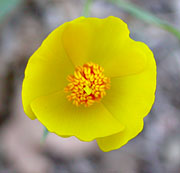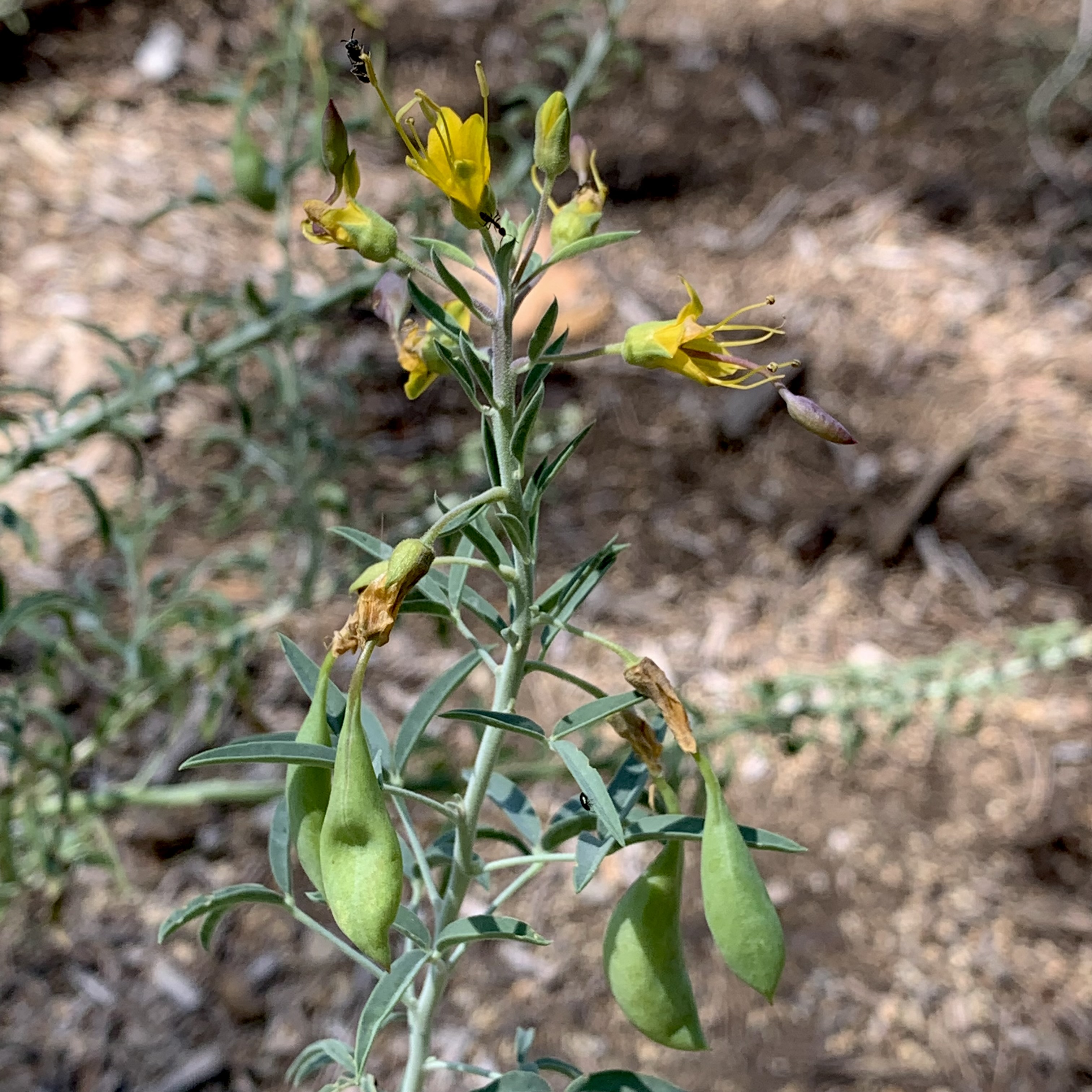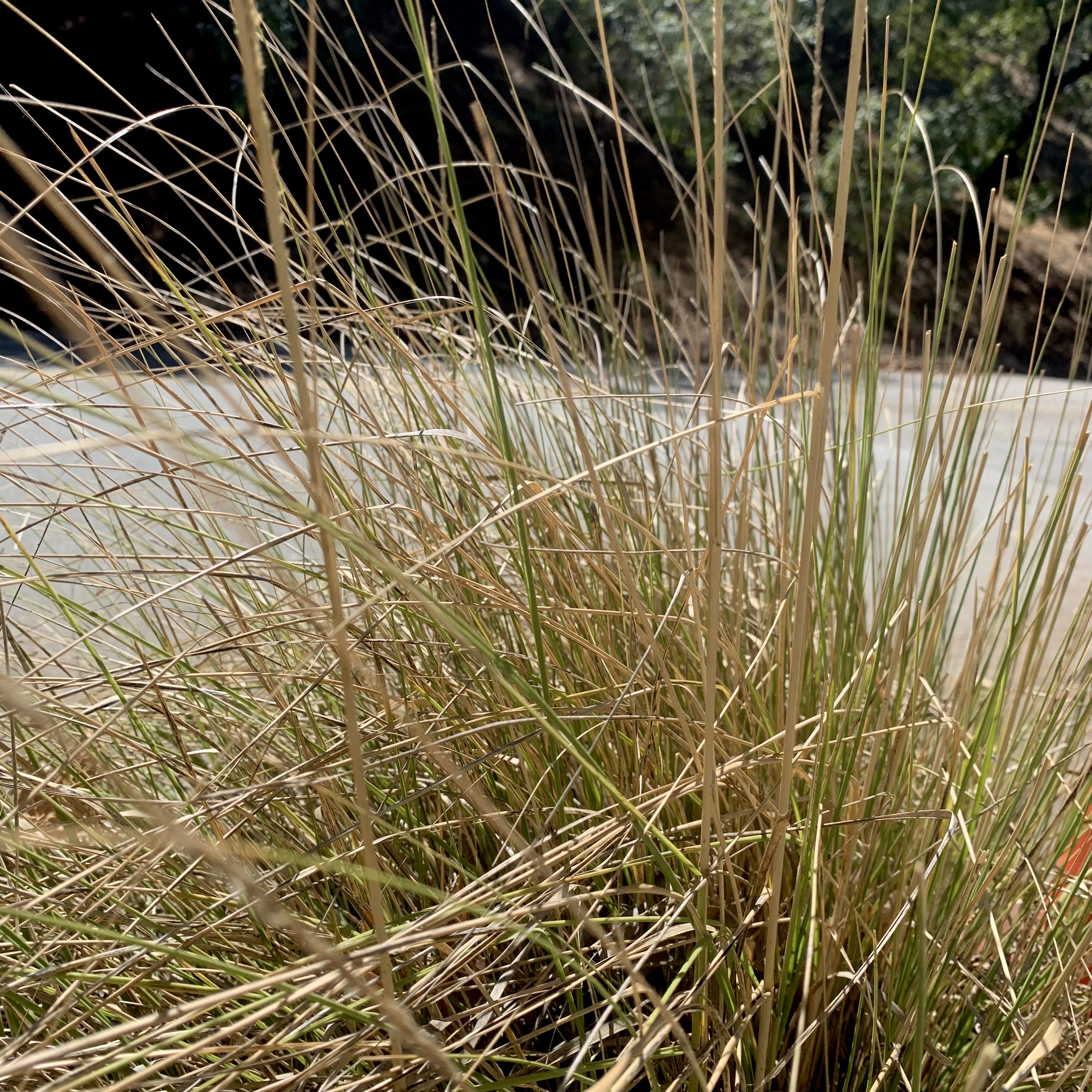Channel Islands
California sagebrush - Artemisia californica
South Coast: coastal scrub, chaparral. California sagebrush is used to bring back pleasant memories by burning it or putting it in a sack to smell. Breathing crushed plant can be calming to help alleviate anger.
Channel island bush poppy - Dendromecon harfordii

Channel Island: shrubby slopes. When preparing tobacco, a leaf or two was added to enhance the strength. Seeds were used for food and straight shoots were used for fire drills! This plant has a unique way of dispersing its seeds with the help of ants!
Chalk dudleya - Dudleya pulverulenta
South Coast: rocky places. This plant also know as "Live-forever" thrives on neglect in the garden and produces spectacular red flowers. The leaf was heated over a flame, one side was peeled and the exposed leaf could then be bound over a corn or callus to remove it. Children would often chew on the leaves with or without salt.
Catalina live forever - Dudleya virens ssp. hassei
Channel Islands: rocks, cliffs. This plant is endemic to Santa Catalina islands. Leaves and flower stalk of many Dudleya species including this species were eaten raw. Poultice from this plant were used on wounds and burns. In the garden, this profusely branching species is the best ground cover Dudleya and also valued for its tolerance to clay soils
Gumplant - Grindelia stricta var. platyphylla
South Coast: Windswept coastal bluffs. A poultice of this plant was used to treat poison-oak rash, skin diseases, or open sores. The gummy exudates or a tincture was also used for poison-oak rash. This plant gets the name Gumplant due to the latex-like material that provided "chewing gum" for native children
Bladderpod - Isomeris arborea

South Coast: coastal bluffs, hills, desert washes. Bladderpod was an important source of food for natives. Pods, flowers and seeds were cooked and eaten. However, this plant is NOT safe to eat until cooked adequately to destroy glucocapparin that can cause irritation and rashes. Gulcocapparin gives the plant a pungent taste.
California black walnut - Juglans californica
South Coast: slopes, canyons, valleys. Nutritious wild walnuts were eaten despite the hard shell and small nut meals. Walnut leaf tea was drunk as blood medicine. Hulls from the nuts were used to make a dark brown dye for basketry materials. The shells were also used for a "dice" game but filling it with asphaltum and abalone.
Giant wildrye - Leymos condensatus
South Coast: dry slopes, open woodland. Giant rye was used to hold tobacco for smoking. Three narrow sticks were inserted in the end to keep the tobacco from falling out. TObacco was often carried in Carrizo worn in the pierced nasal septum or earlobe. Aphids that lived on the cane secrete "honeydew" that is a rich source of sugar.
Fern-leaved Catalina ironwood - Lyonothamnus floribundus ssp. asplenifolius
Channel Islands: slopes, oak woodland, chaparral. This species was known for it's great strength and wood was used to make harpoons with detachable bone point ends. Wooden fighting knives, pointed on both ends for forward and backward thrusts were made with a center hand grip painted with red ochre. Shovel-like implements were also made from this species made for removing abalone.
Island mallow - Malva assurgentiflora
Channel Islands: coastal bluffs. This species was used to treat high fevers and chills, through methods not reported. Other mallows were used to make leaf teas or decoctions for fevers. The leaves help against bee and wasp stings. A more tree-like form is found on the northern islands, and a shrubbier form with larger, glossier leaves are found on the southern islands.
Deergrass - Muhlenbergia rigens

South Coast: canyons, stream bottoms. The foundation of the plant materials were used for coiled baskets. The seeds are edible and were often eaten by natives.
Western sycamore - Platanus racemosa
South Coast: streamsides, canyons. The wood of this tree were used for house construction and bowls used for eating. The bark was used in teas to ease asthma-like symptoms as well as child-birth. The leaf fibers and quail eggs were used to treat sore throats.
Island scrub oak - Quercus pacifica
Channel Islands: chaparral, coastal sage scrub, oak woodland, pine forests. Contorted branches were often exposed by the browsing of feral animals or by the oak moths that defoliate the trees. Windswept terraces on Santa Cruz and Santa Rosa Islands often support a stress-tolerant community with only low growing chamise and island scrub oak.
Island oak - Quercus tomentella
Channel Islands: canyons, slopes, and woodlands. The Island Oak is a relic of California's former climate. Fossil record provides evidence of past mainland populations. This tree is adapted in moist maritime conditions now found only on its island environment. It is the rarest of California's Oak species. Their acorns are so large that is take 18 month to mature!
Santa Catalina island currant - Ribes viburnifolium
Channel Islands: chaparral. This plant has leathery, glossy evergreen leaves that has a spicy fragrance as do them stems. Hummingbirds and bees love the flowers and birds will often use it as cover. This plant has the name currant because of the ribes that lack spines. Children sometimes played a game where they would eat the unripe fruit and see who could eat the most berries without making faces.
Hummingbird sage - Salvia spathacea
South Coast: oak woodland, chaparral. A decoction of leaves, used in moderation was drunk or used as a bath for pulmonary ailments and rheumatism. Unlike most other sage species, this one has leaves that lack a strong odor. Crimson flowers contain large amounts of nectar and are a hummingbird favorite!
